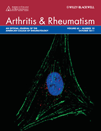Presumptive role of 129 strain–derived Sle16 locus in rheumatoid arthritis in a new mouse model with Fcγ receptor type IIb–deficient C57BL/6 genetic background
Abstract
Objective
Fcγ receptor type IIb (FcγRIIb) is a major negative regulator of B cells, and the lack of FcγRIIb expression has been reported to induce systemic lupus erythematosus (SLE) in mice of the C57BL/6 (B6) genetic background. The 129 strain–derived Sle16 locus on the telomeric region of chromosome 1 including polymorphic Fcgr2b confers the predisposition to systemic autoimmunity when present on the B6 background. We undertook this study to examine the effect of the Sle16 locus on autoimmune disease in FcγRIIb-deficient B6 mice.
Methods
We established 2 lines of FcγRIIb-deficient B6 congenic mouse strains (KO1 and KO2) by selective backcrossing of the originally constructed FcγRIIb-deficient mice on a hybrid (129 × B6) background into a B6 background. Although both lack FcγRIIb expression, the KO1 and KO2 strains carry different lengths of the 129 strain–derived telomeric chromosome 1 segment flanked to the null-mutated Fcgr2b gene; the KO1 strain carries a 129 strain–derived ∼6.3-Mb interval distal from the null-mutated Fcgr2b gene within the Sle16 locus, while this interval in the KO2 strain is of B6 origin.
Results
Unexpectedly, both strains failed to develop SLE; instead, the KO1 strain, but not the KO2 strain, spontaneously developed severe rheumatoid arthritis (RA) with an incidence reaching >90% at age 12 months.
Conclusion
The current study shows evidence that the epistatic interaction between the Fcgr2b-null mutation and a polymorphic gene(s) in the 129 strain–derived interval located in the distal Sle16 locus contributes to RA susceptibility in a new mouse model with the B6 genetic background, although the participation of other genetic polymorphisms cannot be totally excluded.




